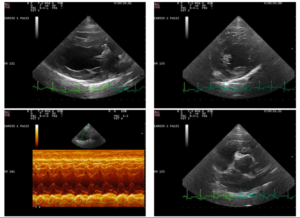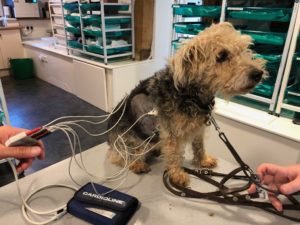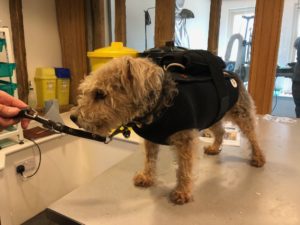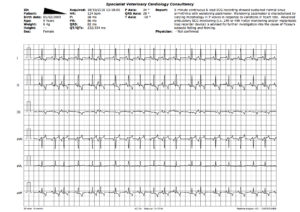Here at the Barn we try to stay abreast of the latest development in Veterinary medicine and surgery but similar to the human medical profession things develop fast. We try to avoid the situation of becoming a “Jack of all trades and master of none” and so from time to time we call upon veterinary colleagues to bring their expertise and specialism to the practice.
One regular visitor to Oak Barn vets is Dr Heidi Ferasin. She is a heart specialist and works with her husband Luca who also specialises in Veterinary Cardiology. We were able to call on their expertise to help with our October case of the month Flossie, a lovely Lakeland terrier who had been having some peculiar fainting episodes from time to time.
Over the course of several months Flossie had had a series of collapsing episodes without any real warning or pattern. One minute she had been her usual self and the next she would appear to faint having gone pale and wobbly.
Her astute owner had brought her to Oak Barn Vets as soon as possible but by then her symptoms had passed and she was back to her usual self. On careful listening of her heart it was clear that Flossie did have a murmur which can indicate the presence of a small leak in one of the heart valves. There was also an occasional change in her heart rhythm which had no obvious pattern or relation to her breathing. Many dogs will have a change in heart rhythm in time with their normal breathing pattern and this is what we call a sinus arrhythmia and often reflects a normal, healthy heart.
As Flossie’s symptoms were thought to be due to a change in the function of her heart we asked Heidi to visit the Barn to have a closer look.
Most of our cardiac patients will undergo a cardiac ultrasound examination (echocardiogram) which provides a moving image of the functioning heart in much the same way as a pregnancy scan gives information. This is done with them awake and the use of a very specialised ultrasound machine and lots of cuddles from our nurses!
Flossie also underwent measurements to track the electrical activity and rhythm of her heart through an ECG (electrocardiogram). Thankfully only mild changes in Flossie’s heart shape and function were found and thought to be an unlikely cause of her episodes but probably responsible for her heart murmur.

Heidi suggested that, given the chance that these events may be related to a change in Flossie’s heart rhythm from time to time, measuring with an ECG over a couple of days of Flossie’s life may uncover a possible cause. To do this Heidi provided us with a holter monitor to fit to Flossie which takes a continuous reading of her heart rate and rhythm over a 48 hour period. You can see what a fantastic patient Flossie was with all her ECG wires and protective vest in place below!


Once all fitted out with a vest and backpack Flossie was ready to go and enjoy a normal 48 hours of eating, sleeping and charging around. Given the rarity of Flossie’s episodes she went through the 48 hours without collapsing but a full record was taken and sent to Heidi.
After a nervous wait the results were back. Other than very occasional and short lived skips in Flossie’s heart her ECG recording was happily very normal. It still remains a mystery what is truly behind Flossie’s episodes, it is hoped that she may have experienced a temporary irregular heart beat due to a now gone viral infection affecting the heart muscle but rest assured we are all keeping a very close eye on her!





